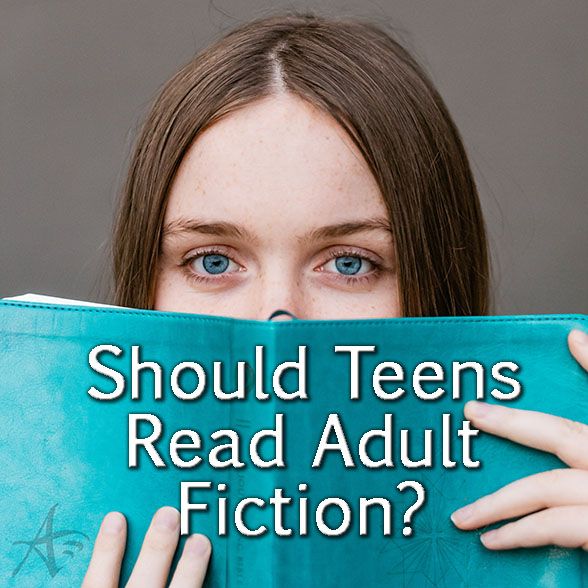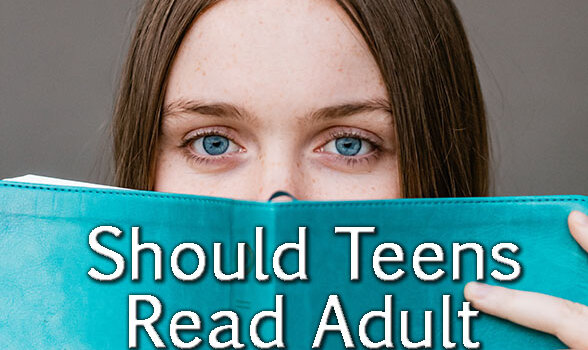Young Adult or Adult Fiction – which is appropriate?

A few decades ago, the Young Adult genre didn’t really exist. Now it’s grown to become arguably one of the biggest book genres. What makes Young Adult unique as a genre is that it doesn’t describe what the book is about, but who it’s for. Other genres such as fantasy, contemporary, and romance give an idea of the book’s content and style, whereas Young Adult instead targets a type of reader, and then adds those other categories as sub-genres to narrow the focus.
So if the genre is intended for young adults, roughly defined as teenagers (with outlying ages as low as 12 or high as 22 depending on the book) should teens only read Young Adult (YA) books? Or should teens read adult books? There are three main factors to consider.
Difficulty
Reading level is important for someone to fully engage with and enjoy a literary work. Children’s literature gradually gets more complex as its target age increases, culminating in the Young Adult genre. In terms of word choice and sentence structure, Young Adult fiction is about as complex as modern Adult fiction. Readers who can handle the Young Adult genre will probably be able understand what is going on in Adult fiction, although some classics and highly literary works may still prove a challenge (for all ages).
When I was in middle school, I wanted more and more to read, and with my advanced skills, I had no problem with vocabulary or sentence structure to stop me from diving into the adult genre to find more books.
So if technical difficulty isn’t a barrier, what’s to stop teens from reading up on the next level?
Themes
One of the big differences between Young Adult books and Adult books (and New Adult books, for that matter) is the theme. Young Adult, since it’s aimed at teenagers, tends to have teens as the main characters and focus on life experiences teens can relate to. For example, first love, friendship, and discovering who you are. There’s a freshness to the handling of these themes with the recognition that the reader is in the season of life where they are exploring and experiencing them fully for the first time.
When I was a teen, the YA books fit my view of the world and were relatable, although I didn’t mind reading Adult books because I could learn from the perspective of characters who had experience more of life than I had.
New Adult books tend to focus on themes surrounding growing into adulthood, such as going out on their own, committing to romantic relationships, and taking on new career responsibilities.
Adult books probably have the greatest variety of themes since they deal with the scope of a whole lifetime. Adult books might not hold anything back from the discussion, which is where the biggest consideration comes in: content.
Content
Movies have a content rating system to advise the viewer of the material’s level of appropriateness. This rating system is absent from books, so you can’t really tell if a book you’re picking up is equivalent to a rating of G or R. And in Adult (and New Adult) fiction, the odds of finding an R are a lot higher than in literature for younger readers. At least, that used to be the case.
Young Adult has trended to an increase in inappropriate or questionable content. Rather than being a cleaner genre than the adult counterpart, YA books are increasingly filled with foul language, extreme violence, and unrestrained sexual encounters.
When I was a teen, young adult fiction wasn’t quite so prevalent, but neither did it match the content levels of Adult fiction. After my first few forays into Adult fiction brought me face to face with a lot of perversion and evil that I wished had never gotten into my head, I decided not to stray out my safe YA genre. It is important to carefully guard yourself from harmful media. But the YA genre is no longer “safe.”
In fact, the new differentiator between Young Adult and Middle Grade (for readers about age 8 to 12) is that in YA the characters will probably swear and have sex, whereas in MG they won’t. How did we get to where inappropriate content became the hallmark of the YA genre? That’s not a question I’ll address here, but the fact is, discernment regarding the content level is now required in both Young Adult and Adult fiction. Adult fiction can still be more explicit and extreme in its portrayal, so the “Young Adult” label might put on a bit of a filter, but by no means is it sufficient anymore.
Look for “clean” Young Adult and Adult fiction
So, since we’ve determined that young adult books aren’t much different in terms of technical difficulty or even content, it seems teens can read in either genre just fine. In fact, I would encourage teens to read in both if you’re interested provided you are careful about which books you choose.
There is a great need for clean books in both the YA and adult genres, and authors are rising up to meet that need. By “clean,” I mean books that aren’t incorporating excessive or inappropriate violence, language, and sex. These are books you can read without oppressing your spirit or feeling dirty or like you’ve been mentally assaulted afterwards.
This year I’ve found quite a few great clean young adult fantasy and adult fantasy authors whose work I can read without fear. I might share some of those in a later post, although if you’re looking for some YA recommendations, any of the books listed in my Author Interview Series are a great place to start.
So, should teens read adult books? I’d say if you want to—and if you’re discerning about which books you read.
Teens, do you read adult books? Do you prefer young adult or adult? Please share!
Please review the Posting Policy before commenting.


